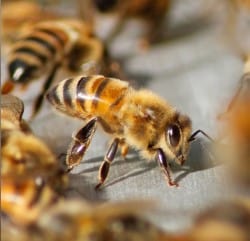Among the most feared insects are the stinging insects, especially the ones that are commonly encountered by humans. These insects are bees, yellow jackets, hornets, and wasps. They are very notorious because they are the ones that usually attack people when accidentally provoked and these attacks can sometimes be fatal. In this article, you will learn how these insects fly and how fast their top speed is. So make sure to take notes to know how fast you need to run in case you encounter them.
How fast can bees, yellow jackets, hornets, and wasps fly? Bees have a speed of 12 to 20 mph, yellow jackets (a type of wasp) range from 6 to 30 mph and hornets up to 25 mph.
| Insect | Average Flight Speed | Fastest Flight Speed |
| Honey bee | 12mph | 20mph |
| Bumble bee | 7mph | 33mph |
| Yellow Jacket | 7mph | 30mph |
| Hornet | 14mph | 25mph |
To clear everything up, yellow jackets belong to the wasps family but a wasp does not necessarily mean it is the same as a yellow jacket. It is also worth mentioning that hornets are also technically part of the wasp family and yellow jackets can be considered ground nesting hornets. To put it in a simpler explanation, yellow jackets are ground-nesting wasps and hornets are larger sized wasps. To understand how these winged insects fly and how they gain their speed during flight read further.
Table of Contents
How do bees fly?
Bees are very fascinating insects. Given their body’s size and weight, they should not be able to fly with such small wings; but they do.
Turns out, bees have two sets of wings. A larger outer set and a smaller inner set that is connected to each other by small comb-like teeth, producing a larger surface that helps bees create better lift and fly.

A special muscle contracts a bees thorax and causes the wings to beat very fast which is the source of the buzzing sound that bees make. The muscles contract alternately in a rhythmic fashion and which can be compared to how your lungs expand and contract, this muscle movement allows the bees to beat their wings back and forth.
In the beginning, biologists believed that a bee’s wings are very rigid similar to that of an airplane’s wings. However, the same biologists also argued that if that is the case, the size of the bees wings makes it impossible for them to produce enough lift to make them fly. The topic remained a mystery for 80 years but with the advent of technology, high definition video capturing gave the experts the edge they need to figure this one out.
Allow me to quote an opening line that I heard on one of the many children movies I’ve watched with my kid. This movie is entitled “Bee Movie” and the line goes like this:
“According to all known laws of aviation, there is no way that a bee should be able to fly. Its wings are too small to get its fat little body off the ground. The bee, of course, flies anyway. Because bees don’t care what humans think is impossible.”
Bee Movie
I included this because, through my research, I found out that this particular line was taken from an answer by Jack Fraser (who master’s physics in the University of Oxford in 2018), to the question “How does a bee fly? Could we fly like bees do?”. He then added that this is a myth and us humans do know and understand how they are able to fly.
Speed of the most common bee species
The numerous bee attack incidents have experts studying the behavior of bees in the hopes of gaining knowledge on how to prevent them. But for the sake of having some idea on how fast bees fly, let’s take three of the most common bees including the infamous killer bees as examples.
How fast do Honey Bees fly?
The honey bee is among the species of bees that are responsible for the majority of honey supply in the world. They work non-stop even during the winter months. They have the ability to beat their wing up to 230 times per second according to Douglas Altshuler who is a researcher at the California Institute of Technology.

Normally, worker honey bees have the flight speed capacity of 15 miles per hour. This speed is mostly recorded on workers that are flying to a food source. Their speed decreases to 12 miles per hour on the return due to the extra load of pollen, nectar or water they are carrying.
However, the fastest speed recorded from a honey bee is 20 miles per hour and this is seen when bees attack predators of their hives.
How fast do Bumblebees fly?
Bumblebees are a species of bees that do not produce honey. They are very common in agriculture because they are perfect for pollinating plants and crops. In fact, experts have deemed this species to be important agricultural pollinators. That is why the decline of their population raised concern in the industry.

Bumblebees have the ability to beat their wings at around 200 times or more per second. They generally, search nectars from sources that are 1 to 2 yards away from their hive and continue to visit the same area until the food source is depleted. Depending on what their activity is, a bumblebee has the flight speed of 6.75 miles per hour on a normal day.
However, the fastest recorded flight speed of bumblebees is 33 miles per hour. That is very fast considering their size and shape.
How fast do Africanized Honey Bees fly?
Let us now move on to the most notorious species of bees, the infamous Africanized honey bee or more commonly referred to as killer bees. They gained this name due to their aggressive behavior. They are very protective of their hives compared to other bee species. Any slight provocation, like loud sounds or vibrations. Killer bees have been recorded to have killed about 1,000 or more humans and also have been recorded to have attacked and killed other animals. All victims received more than 10 times the sting compared to honey bees.

Experts have studied these bees and found out that they will chase a human for literally as long as necessary. Normal honeybees will only give chase for around 100 yards but interestingly, Africanized honey bees fly the same speed as that of the regular honey bee – around 12 – 20 miles per hour. What makes them deadly is that when they are provoked (and they easily are), they launch an attack that involves a larger swarm than that of regular honey bees and they chase their victim farther than other bee species.
How do yellow jackets fly?
Yellow jackets or yellow jackets, as some people write them, is one of the many insect species that are considered as pests. This is mainly due to them building their nests in places where humans are present like house eaves, above your door, in your attic, under a flower pot or underground near a picnic site. Another reason is that these flying insects can sting you not just once but multiple times.

Most yellow jackets are not aggressive by nature. Even if they are not aggressive, this does not mean that they will not defend their nest with their sting. Female yellow jackets are equipped with stingers that they can use multiple times. Once you have been identified as a threat then your best course of action is to run. Experts say that the top speed of this insect is up to 6 to 7 miles per hour which is a speed that a human can easily outrun.
After doing some research (more like a lot of research), yellow jackets move their wings in the same manner as a bees does. They have 2 sets of wings too, bigger forewing and smaller hindwing just like a bee’s attached to their thorax. However, yellow jackets rest their wing lengthwise when they land while bees fan their wings out a bit while feeding.
How do hornets fly?
Hornet is a part of the Hymenoptera order of insects like bees and yellow jackets. It means that the insects belonging in this order possess two sets of wings. One set of bigger and longer outer wing and another set of inner wings that are shorter and smaller. Hornets, however, are omnivorous like their close cousin the yellow jacket.

Late autumn is the time of year that hornets are often aggressive. This is when their new queen is developed which is why the colony becomes more protective. They are capable of flying up to 13 to 14 miles per hour and beat their wings to about 100 beats per second.
The fastest flight speed of hornets belongs to the Asian giant hornet which can fly up to 25 miles per hour.
Can a human outrun bees, wasps and hornets and should you try to?
An average healthy human has a running speed of about 20 miles per hour, unless you are Usain Bolt who clocked 28 miles per hour. Bees top speed ranges from 15 to 20 miles per hour, yellow jackets can reach 6 to 7 miles per hour and Hornets at 25 miles per hour. Given all that data, it can be concluded that an average healthy human can outrun all three insects. However, there are a few factors that may affect this conclusion such as age and health status.
Children and elderly people may have a hard time outrunning these stinging insects because kids have shorter legs, therefore, is slower and elderly people move slower than a person in his prime. Also, people who are suffering from an injury may not be able to outrun these insects.
As for the question, should you try outrunning them, yes. If you are targeted by any of these insects your main objective is to run away as far from the hive as fast as you can. The best thing to do is to run in one direction until the assault stops.
Conclusion
Bees, yellow jackets, hornets, and wasps are all part of a single insect order called Hymenoptera, where all species have two sets of wings. This is the reason why all of these insects fly the same way. A healthy human may be able to outrun any of these insects. Anyone who has accidentally disturbed a nest of any of these insects should not hesitate from running away because you will probably get stung if you don’t. However, seek safety as soon as possible to avoid being followed by too many, especially the Africanized Bees.
